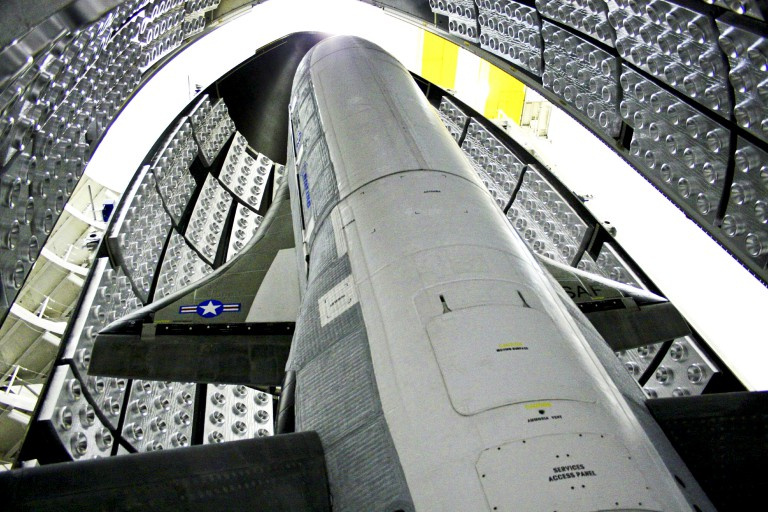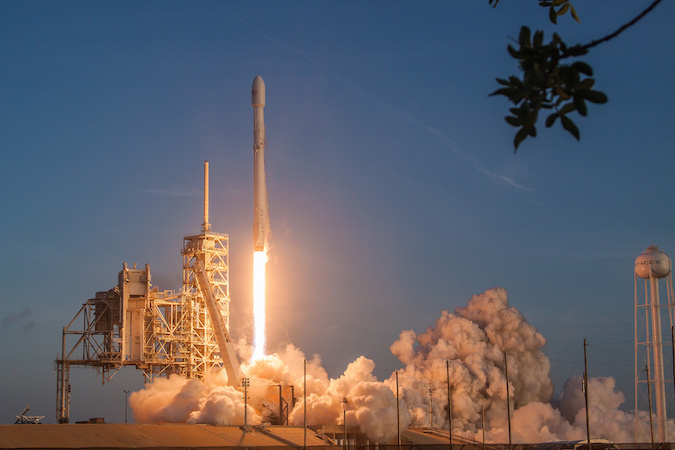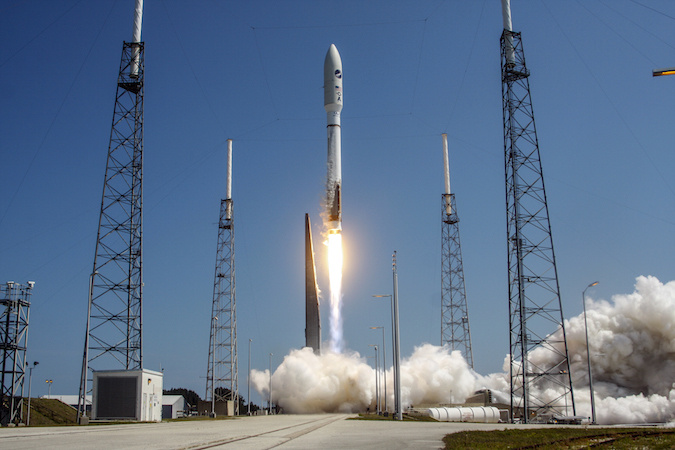USAF selects SpaceX for fifth flight of X-37B spaceplane
June 6, 2017, Stephen Clark

Archival photograph of the X-37B spaceplane inside the cone of the nose cone of the AtlasV ULA rocket before the first test flight in April 2010 © United States Air Force
A month after the X-37B mini space shuttle descended from orbit to land on the runway of the Kennedy Cosmodrome, Florida, the US Air Force announced [on Tuesday 6 June] that the next spaceplane mission would go into space on board the Falcon9 SpaceX rocket in August 2017.
According to a previously secret launching contract, the Falcon9 rocket will be used for the first time to launch one of the two X-37B spacecraft X-37B built by Boeing, which have already had a total of 2085 days flying over the Earth.
US Air Force Minister Heather Wilson , showing the model of an unmanned spaceplane, revealed plans to launch the fifth mission of the X-37B during the hearing of the US Senate Committee on Armed Forces on Tuesday, June 6, 2017 .
“The X37 will fly again,” Wilson said. "This is a reusable device and it will be raised again on the SpaceX rocket in August."
Managed by the Rapid Response Division of the Air Force and built by the Phantom Works division of Boeing, the X-37B spaceplanes are four times smaller than the SpaceShuttle shuttle : the length of each spacecraft is more than 8.9 meters, and its wingspan is almost 4.5 meters.
The weight of the X-37B is about 5 tons and they usually fly over the Earth in orbits at an altitude of 320-400 km.
X-37B spaceplanes, also known as Orbital Flying Laboratories ( OTV ), are lifted nested inside payloads of conventional missiles, and after launching into orbit and opening the compartment, they open their solar panels. Space planes sit down like an airplane back to Earth.

Towing the X-37B space plane to a hangar near the Vertical Assembly Building of the Kennedy Space Center in Florida, after landing on May 7 © United States Air Force
The four previous missions of the ship were launched on an AtlasV ULA rocket from Cape Canaveral, and each subsequent mission spent more time in orbit than the previous one.
X-37B spaceplanes flew inside a short version of a five-meter class fairing shell, on an AtlasV rocket without additional solid-fuel boosters, a configuration that ULA calls AtlasV-501 . The Falcon9 has a standard nose cone for loads of approximately the same diameter and length as the short five-meter version of the AtlasV envelope.
The latest flight, called the OTV-4, ended on May 7 with the first landing of the X-37B on the former landing strip for space shuttles at the NASA Kennedy Space Center in Florida after 718 days in orbit. The previous three missions landed at Vandenberg Air Force Base in California, but the Air Force and Boeing moved launch, landing and control operations to the Florida space center, taking up two hangars previously used for space shuttles near the famous Vertical Building .
The X-37B space missions are not completely secret, but landing on autopilot in May was the first time that the planned return of the ship was not announced to the Air Force in advance. Also, interrupting the practice of early declassification of flights that took place, the Air Force did not disclose which of the two vehicles flew in the OTV-4 mission.
Army officials also did not identify Tuesday [June 6] - which spacecraft was selected for the fifth flight of the X-37B.
"We are very excited about waiting for the fifth mission of the X-37B," said Randy Walden , director of the BBC's rapid response unit. “We look forward to the continued expansion of the spacecraft’s work and are pleased to continue deploying experimental payloads for the benefit of the space community.”

Archival photograph of the Falcon9 launch from the launch pad 39A at the Kennedy Cosmodrome in Florida. © SpaceX
The Air Force said in a statement on Tuesday [June 6] that the fifth flight of the X-37B will include several unique events.
"This mission will be the first launch of the program with the help of the upgraded Falcon9 SpaceX rocket," said the BBC. "The program also continues to develop its cooperation in the fourth mission with experimental partners."
According to the military, the Air Force Research Laboratory will test the experimental electronics and oscillating heat pipes on the fifth long-term flight of the X-37B.
Other flight tasks remain secret.
“The ability to run [Orbital Flying Labs] OTV on multiple platforms will provide flexible launch options for the developers of our experiments,” Walden said in a statement. “We are delighted with this new partnership to create reliable and flexible launch options and are confident in SpaceX’s ability to provide secure and guaranteed access to space for the X-37B program.”
The Falcon9 SpaceX rocket was certified by the Air Force to launch sensitive and expensive national security payloads in 2015. Since then, the Air Force awarded SpaceX contracts to launch two GPS navigation satellites and several more missile launch contracts have been in place to fight between SpaceX and ULA until 2019.

Archival photograph of the launch of the fourth mission X-37B in May 2015 on a ULA AtlasV rocket © ULA
Before SpaceX was certified, the Air Force gave away ULA launch contracts in the form of “package purchases” for a single contractor.
However, the rocket contract for the fifth mission of the X-37B was not included in the list of planned competitive space launches provided by Air Force officials in recent months.
SpaceX has up to half a dozen launches in its schedule before the X-37B mission in August, mainly the launch of commercial communications satellites. The company seeks to resume flights from launch pad No. 40 of the cosmodrome at Cape Canaveral by September, after brigades repair damage to the site from the Falcon9 rocket explosion in September.
Until then, all launches of Falcon9 rockets from Florida will be made from the 39A site of the Kennedy Cosmodrome, the starting point for the Apollo lunar missions and most of the flights of space shuttles.
Officials did not indicate which Florida launch site Falcon9 would take off from on the fifth flight of the X-37B, and SpaceX said last week that they had not determined which mission would be next to take off from Site No. 40.
Wilson, who had been the main civilian in the Air Force for three weeks already [i.e. occupies the post of Air Force Minister], lawmakers said on Tuesday [June 6] that the highly competitive US rocket market sends launch prices down, giving the military two certified contractors and providing access to the launch reserve supplier if one of the launch vehicles has malfunction.
The Pentagon established a policy of "guaranteed access to space" after a series of unsuccessful launches in the 1990s, and the fleets of ULA Atlas and Delta missiles provided redundancy for military launches until the Falcon9 SpaceX appeared on the market.
“We had a huge problem in the 1990s with access to space, and the country at that time made significant investments in its space capabilities, as well as its ability to launch, and it paid for itself and shows results,” said Wilson. “The advantage is that we see competition, and this reduces the price of access to space.”

Archival photograph of the X-37B spaceplane inside the cone of the nose cone of the AtlasV ULA rocket before the first test flight in April 2010 © United States Air Force
A month after the X-37B mini space shuttle descended from orbit to land on the runway of the Kennedy Cosmodrome, Florida, the US Air Force announced [on Tuesday 6 June] that the next spaceplane mission would go into space on board the Falcon9 SpaceX rocket in August 2017.
According to a previously secret launching contract, the Falcon9 rocket will be used for the first time to launch one of the two X-37B spacecraft X-37B built by Boeing, which have already had a total of 2085 days flying over the Earth.
US Air Force Minister Heather Wilson , showing the model of an unmanned spaceplane, revealed plans to launch the fifth mission of the X-37B during the hearing of the US Senate Committee on Armed Forces on Tuesday, June 6, 2017 .
“The X37 will fly again,” Wilson said. "This is a reusable device and it will be raised again on the SpaceX rocket in August."
Managed by the Rapid Response Division of the Air Force and built by the Phantom Works division of Boeing, the X-37B spaceplanes are four times smaller than the SpaceShuttle shuttle : the length of each spacecraft is more than 8.9 meters, and its wingspan is almost 4.5 meters.
The weight of the X-37B is about 5 tons and they usually fly over the Earth in orbits at an altitude of 320-400 km.
X-37B spaceplanes, also known as Orbital Flying Laboratories ( OTV ), are lifted nested inside payloads of conventional missiles, and after launching into orbit and opening the compartment, they open their solar panels. Space planes sit down like an airplane back to Earth.

Towing the X-37B space plane to a hangar near the Vertical Assembly Building of the Kennedy Space Center in Florida, after landing on May 7 © United States Air Force
The four previous missions of the ship were launched on an AtlasV ULA rocket from Cape Canaveral, and each subsequent mission spent more time in orbit than the previous one.
X-37B spaceplanes flew inside a short version of a five-meter class fairing shell, on an AtlasV rocket without additional solid-fuel boosters, a configuration that ULA calls AtlasV-501 . The Falcon9 has a standard nose cone for loads of approximately the same diameter and length as the short five-meter version of the AtlasV envelope.
The latest flight, called the OTV-4, ended on May 7 with the first landing of the X-37B on the former landing strip for space shuttles at the NASA Kennedy Space Center in Florida after 718 days in orbit. The previous three missions landed at Vandenberg Air Force Base in California, but the Air Force and Boeing moved launch, landing and control operations to the Florida space center, taking up two hangars previously used for space shuttles near the famous Vertical Building .
The X-37B space missions are not completely secret, but landing on autopilot in May was the first time that the planned return of the ship was not announced to the Air Force in advance. Also, interrupting the practice of early declassification of flights that took place, the Air Force did not disclose which of the two vehicles flew in the OTV-4 mission.
Army officials also did not identify Tuesday [June 6] - which spacecraft was selected for the fifth flight of the X-37B.
"We are very excited about waiting for the fifth mission of the X-37B," said Randy Walden , director of the BBC's rapid response unit. “We look forward to the continued expansion of the spacecraft’s work and are pleased to continue deploying experimental payloads for the benefit of the space community.”

Archival photograph of the Falcon9 launch from the launch pad 39A at the Kennedy Cosmodrome in Florida. © SpaceX
The Air Force said in a statement on Tuesday [June 6] that the fifth flight of the X-37B will include several unique events.
"This mission will be the first launch of the program with the help of the upgraded Falcon9 SpaceX rocket," said the BBC. "The program also continues to develop its cooperation in the fourth mission with experimental partners."
According to the military, the Air Force Research Laboratory will test the experimental electronics and oscillating heat pipes on the fifth long-term flight of the X-37B.
Other flight tasks remain secret.
“The ability to run [Orbital Flying Labs] OTV on multiple platforms will provide flexible launch options for the developers of our experiments,” Walden said in a statement. “We are delighted with this new partnership to create reliable and flexible launch options and are confident in SpaceX’s ability to provide secure and guaranteed access to space for the X-37B program.”
The Falcon9 SpaceX rocket was certified by the Air Force to launch sensitive and expensive national security payloads in 2015. Since then, the Air Force awarded SpaceX contracts to launch two GPS navigation satellites and several more missile launch contracts have been in place to fight between SpaceX and ULA until 2019.

Archival photograph of the launch of the fourth mission X-37B in May 2015 on a ULA AtlasV rocket © ULA
Before SpaceX was certified, the Air Force gave away ULA launch contracts in the form of “package purchases” for a single contractor.
However, the rocket contract for the fifth mission of the X-37B was not included in the list of planned competitive space launches provided by Air Force officials in recent months.
SpaceX has up to half a dozen launches in its schedule before the X-37B mission in August, mainly the launch of commercial communications satellites. The company seeks to resume flights from launch pad No. 40 of the cosmodrome at Cape Canaveral by September, after brigades repair damage to the site from the Falcon9 rocket explosion in September.
Until then, all launches of Falcon9 rockets from Florida will be made from the 39A site of the Kennedy Cosmodrome, the starting point for the Apollo lunar missions and most of the flights of space shuttles.
Officials did not indicate which Florida launch site Falcon9 would take off from on the fifth flight of the X-37B, and SpaceX said last week that they had not determined which mission would be next to take off from Site No. 40.
Wilson, who had been the main civilian in the Air Force for three weeks already [i.e. occupies the post of Air Force Minister], lawmakers said on Tuesday [June 6] that the highly competitive US rocket market sends launch prices down, giving the military two certified contractors and providing access to the launch reserve supplier if one of the launch vehicles has malfunction.
The Pentagon established a policy of "guaranteed access to space" after a series of unsuccessful launches in the 1990s, and the fleets of ULA Atlas and Delta missiles provided redundancy for military launches until the Falcon9 SpaceX appeared on the market.
“We had a huge problem in the 1990s with access to space, and the country at that time made significant investments in its space capabilities, as well as its ability to launch, and it paid for itself and shows results,” said Wilson. “The advantage is that we see competition, and this reduces the price of access to space.”
Survey Note
I am not a translator, that is why I have such a big lag - the news is already from June 6th, but I just finished its translation and editing just now (╯ ° □ °) ╯︵ ┻━┻
Why am I doing this - because I want to see more such news on Giktimes, and no one else translates or reprints it ...
Why am I doing this - because I want to see more such news on Giktimes, and no one else translates or reprints it ...
All Articles